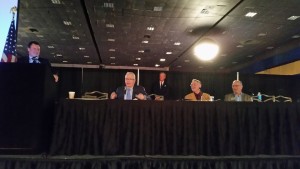
Controversy at CIC over three tiers of shops considered ‘Class A’
By onAssociations | Business Practices | Repair Operations
A proposed definition of what constitutes a “Class A” shop drew controversy Tuesday at CIC for dividing collision repairers into three tiers based on competency and repair type — but allowing all to be known as “Class A.”
The sample document (here’s a version we cobbled together from handout photos) drafted over the course of the year by the Collision Industry Conference’s Definitions Committee would replace the Class A minimum requirements.
The latter was “wholly inadequate,”CIC Chairman Randy Stabler said during the SEMA week gathering in Las Vegas.
A Google Docs version open to feedback should be coming next week. The committee also directed repairers to a new “Compliance & Sustainability” website meant to help repairers also meet state and federal regulations. Such compliance was part of all three Class A categories. (Plus, the feds or state regulators could go after you if you weren’t doing it anyway.)
The new version — which the panel stressed was just a draft, encouraging feedback — would divide “Class A” shops into three tiers: Non-Structural/Cosmetic, Structural and strStructural Advanced Materials and Techniques.
A nonstructural Class A shop would be able to do any refinishing and “light sheet metal repairs” which didn’t involve any pulling or welding on a structural part.
A structural Class A shop has the competence and gear to “perform repairs and refinish work on steel vehicles including structural repairs and welding on replacement structural components.”
A structural-advanced materials Class A shop would have the expertise and gear to work on “steel and advanced material vehicles such as aluminum, carbon fiber, etc. including structural repairs and replacing structural components.”
The middle “Structural” shop, if we’re right in assuming the panel referred to structural steel on older cars, seems as though it’d be irrelevant in a decade or so. Over the past year, we’ve covered numerous mainstream models which shifted to ultra-high-strength steel or aluminum — or combined the two — with their latest generation. As the American fleet ages and is replaced by newer models, you’ll be able to repair fewer and fewer vehicles the old ways.
Society of Collision Repair Specialists Executive Director Aaron Schulenburg raised that point, urging the panel to treat ultra-high-strength steel — which generally can’t be repaired like more traditional steels without a risk to the driver — as an advanced material.
Schulenburg said the document seemed to be a way to give Class B and C-level businesses a pass by letting them all be Class As, rather than using Class A to highlight repairers who’d invested in training and equipment and possessed more advanced capabilities.
A DRP or other shop network could just say, “All my shops are Class A,” Schulenburg said.
Amber Alley, a SCRS board member and manager at Barsotti’s Body and Fender, also argued that the document seemed to undercut OEM certifications with its references to OEM specifications.
“In no way is this work intended to water down or take anything away from an existing OE certification that you have,” committee Chairman Chris Evans said.
The draft definition does crack down on situations where shops have a single trained or certified I-CAR technician to “check a box,” requiring anybody who will be doing the work to have the necessary coursework.
We’ll be getting into more of the debate at a later date. Continue to check RDN for updates.
